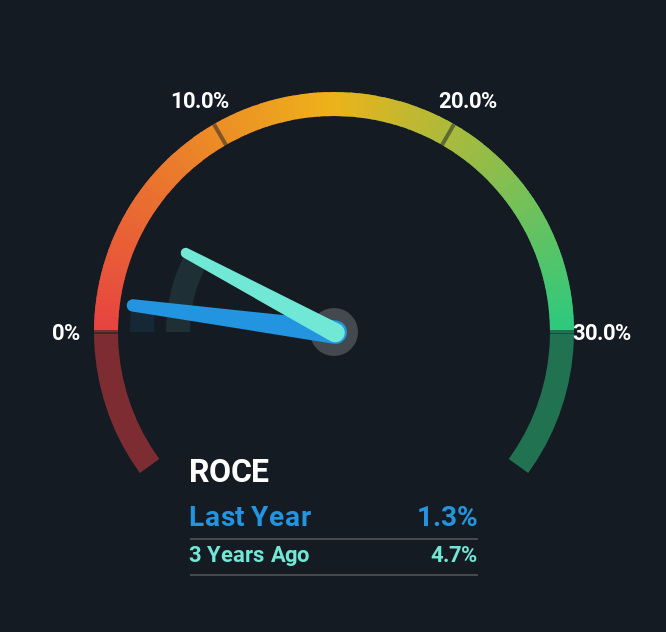When we're researching a company, it's sometimes hard to find the warning signs, but there are some financial metrics that can help spot trouble early. A business that's potentially in decline often shows two trends, a return on capital employed (ROCE) that's declining, and a base of capital employed that's also declining. Ultimately this means that the company is earning less per dollar invested and on top of that, it's shrinking its base of capital employed. So after we looked into NANO (KOSDAQ:187790), the trends above didn't look too great.
What Is Return On Capital Employed (ROCE)?
For those that aren't sure what ROCE is, it measures the amount of pre-tax profits a company can generate from the capital employed in its business. Analysts use this formula to calculate it for NANO:
Return on Capital Employed = Earnings Before Interest and Tax (EBIT) ÷ (Total Assets - Current Liabilities)
0.013 = ₩503m ÷ (₩87b - ₩47b) (Based on the trailing twelve months to March 2025).
Thus, NANO has an ROCE of 1.3%. In absolute terms, that's a low return and it also under-performs the Chemicals industry average of 7.3%.
View our latest analysis for NANO

While the past is not representative of the future, it can be helpful to know how a company has performed historically, which is why we have this chart above. If you're interested in investigating NANO's past further, check out this free graph covering NANO's past earnings, revenue and cash flow.
What Does the ROCE Trend For NANO Tell Us?
We are a bit anxious about the trends of ROCE at NANO. Unfortunately, returns have declined substantially over the last five years to the 1.3% we see today. What's equally concerning is that the amount of capital deployed in the business has shrunk by 46% over that same period. When you see both ROCE and capital employed diminishing, it can often be a sign of a mature and shrinking business that might be in structural decline. Typically businesses that exhibit these characteristics aren't the ones that tend to multiply over the long term, because statistically speaking, they've already gone through the growth phase of their life cycle.
While on the subject, we noticed that the ratio of current liabilities to total assets has risen to 54%, which has impacted the ROCE. If current liabilities hadn't increased as much as they did, the ROCE could actually be even lower. And with current liabilities at these levels, suppliers or short-term creditors are effectively funding a large part of the business, which can introduce some risks.
The Bottom Line On NANO's ROCE
In summary, it's unfortunate that NANO is shrinking its capital base and also generating lower returns. But investors must be expecting an improvement of sorts because over the last five yearsthe stock has delivered a respectable 68% return. Regardless, we don't feel too comfortable with the fundamentals so we'd be steering clear of this stock for now.
Since virtually every company faces some risks, it's worth knowing what they are, and we've spotted 2 warning signs for NANO (of which 1 is a bit unpleasant!) that you should know about.
While NANO may not currently earn the highest returns, we've compiled a list of companies that currently earn more than 25% return on equity. Check out this free list here.
Valuation is complex, but we're here to simplify it.
Discover if NANO might be undervalued or overvalued with our detailed analysis, featuring fair value estimates, potential risks, dividends, insider trades, and its financial condition.
Access Free AnalysisHave feedback on this article? Concerned about the content? Get in touch with us directly. Alternatively, email editorial-team (at) simplywallst.com.
This article by Simply Wall St is general in nature. We provide commentary based on historical data and analyst forecasts only using an unbiased methodology and our articles are not intended to be financial advice. It does not constitute a recommendation to buy or sell any stock, and does not take account of your objectives, or your financial situation. We aim to bring you long-term focused analysis driven by fundamental data. Note that our analysis may not factor in the latest price-sensitive company announcements or qualitative material. Simply Wall St has no position in any stocks mentioned.
About KOSDAQ:A187790
NANO
Manufactures and sells SCR DeNOx catalysts to remove nitrogen oxide and dioxin in Korea and internationally.
Solid track record with adequate balance sheet.
Market Insights
Community Narratives





